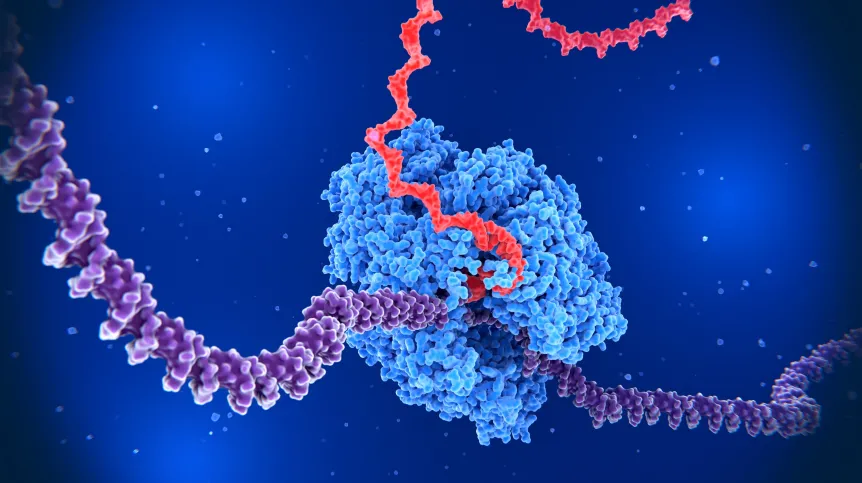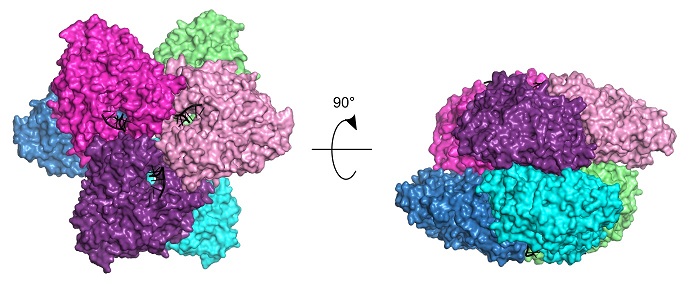
There are proteins that produce DNA on their own and are used by bacteria to commit suicide. The morphology and functioning of such structures have been described by scientists from the International Institute of Molecular and Cell Biology.
RECIPES FOR RECIPES
DNA can be treated as a cookbook, in which recipes for life are written, and more specifically - recipes for various proteins, small machines that build a cell and do all the work in it. Such a recipe is first translated into another nucleic acid, RNA, which then produces the protein. There are also special proteins (called reverse transcriptases) that can do the reverse translation - use RNA to produce DNA encoding the same information (and thus with an analogous sequence). It turns out, however, that there are also specialized reverse transcriptases that independently produce long strands of DNA with random sequences.
Such proteins include bacterial AbiK proteins investigated by researchers from the institute’s Professor Marcin Nowotny. Their paper published in the prestigious Nucleic Acids Research was recognized as the best work of the year and received the Jakub Karol Parnas Award of the Polish Biochemical Society. The scientists were the first to describe the spatial structure of such a protein at the level of individual atoms.
A BIRD OF PARADISE AMONG PROTEINS
'This enzyme is like a bird of paradise among proteins. Yes, you can study storks or swallows that are much easier to observe, but when we discover the mating habits of birds of paradise, we get the impression that a new, fascinating world opens up to us. The same is true of these proteins! It is a real new cosmos,’ says Professor Nowotny, winner of last year's FNP Prize.
(The mating habits of birds of paradise can be seen here).
The first author of the paper and the initiator of the project Dr. Małgorzata Figiel explains that AbiK proteins are produced, for example, by Lactococcus lactis bacteria, well-known in the dairy industry. These bacteria produce the AbiK protein in response to viral attack.
HONOURABLE SUICIDE OF SINGLE-CELLED ORGANISMS
The recipes on the basis of which the AbiK proteins are created are not recipes for life, but quite the opposite: recipes for the death of the organism's own cell. When this enzyme is triggered, it starts spitting out DNA 'spaghetti' inside the cells. As a result, the cell dies. Thus, this protein is the tool by which the bacterial cell commits suicide.

It is part of the war between bacteria and viruses - bacteriophages that use bacteria as a vehicle to multiply. When a bacterium detects that it has been infected by a hostile virus, it has a choice: die from the infection, spreading death to other bacteria in the process; or commit an honourable suicide before the viruses for the deadly colony multiply within it. And it turns out that evolution has promoted the second possibility. It may be hard to imagine, but even a single-celled organism like a bacterium can be capable of heroic altruism: it can perform seppuku (Japanese ritualistic suicide by disembowelment) to protect its fellow bacteria.
For now, there are still a lot of unknowns when it comes to how this protein works, for example, what makes the protein go into action and how the appearance of DNA spaghetti leads to cell death.
PROTEIN PRINTERS
Thanks to the work of the Polish researchers, however, we already know the shapes that this protein takes at various stages of its work.
'It was amazing! We saw these proteins, for example, at the time when DNA was still attached to them,’ Nowotny says.
Dr. Figiel adds: 'I thought that these DNA-producing structures looked like some kind of flying spaghetti monster.’ Explaining that it was six identical polymerases combined into one ball, she says the structures were 'hugging each other, spitting out all the strands of DNA at once. It was a beautiful, symmetrical and completely unusual structure.’
'It would not be possible to determine such a structure if we only used the artificial intelligence proposal - the AlphaFold program that suggests the possible structure of the protein,’ says Professor Nowotny. He adds that the team is very happy to use the help of AI. Thanks to the use of these methods, work on a new structure takes much less time now.
'We were the first to show, at the molecular level, the functioning of this extraordinary enzyme, which synthesizes DNA on its own. It does not need a template, i.e. another nucleic acid (DNA or RNA), which serves as a model,’ he says.
Dr. Figiel adds that it does not require the so-called 'starter' - the initial fragment from which DNA production starts and which other reverse transcriptases need. Instead, the protein starts DNA production by attaching its first building block to itself.
The researcher points out that reverse transcriptases of the hepatitis B virus HBV start weaving DNA in a similar way. Such DNA formation is a key moment of infection. Unfortunately, researchers have not been able to describe such viral DNA printers for decades. 'So I started looking for proteins that would function similarly to the viral ones. And that was how I came across this 'cosmic' AbiK protein in lactic acid bacteria, she says.
ENZYMATIC GOLDMINES
The DNA spat out by the AbIK protein has a random arrangement - the 'letters' that make up the DNA strand do not have any predetermined order.
Researchers hope that such protein DNA printers can be modified so that they print DNA with a predetermined sequence. Enzymatic DNA printers are a growing field of knowledge with a wide range of applications.
Another idea is to use the AbiK protein in the fight against bacterial infections. If researchers manage to find a way to activate the AbiK protein, it may be possible to initiate the suicide of the bacteria. In this way, this mechanism could be used not to ensure the survival of bacterial colonies, but instead to lead to mass suicide of bacteria and defend the organism colonized by them - for example in the treatment of infection with antibiotic-resistant bacteria.
'Research on proteins involved in the defence of bacteria against viruses is an exploding field of science, it is a goldmine, explains Professor Nowotny. He adds that one of the proteins of this type was the Cas9 protein, an element of the groundbreaking, Nobel Prize-winning CRISPR system, already widely used in gene editing laboratories.
'This means that our research is not out of touch with reality. We hope that this knowledge can be used to build tools with enormous potential,’ concludes Dr. Figiel.
PAP - Science in Poland, Ludwika Tomala
lt/ agt/ kap/
tr. RL












